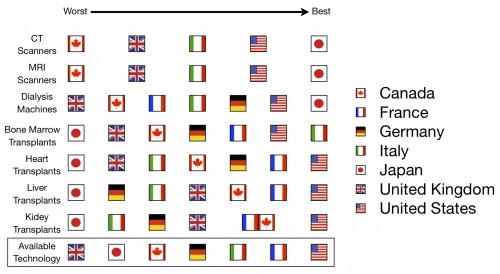If you haven’t read the introduction, go back and read it now. That introductory post also includes links to all the posts in this series on how we can rate the quality of the US health care system. Each of these pieces will discuss another way to look at quality, and how the US compares to comparable countries in that domain.
One way to measure quality, at least to some, is to note how much technology is available. The thinking is that more technology means more advances, or at least better outcomes. In other words, better health care systems have more technology. So measures of a system’s technology are metrics that can be used to measure quality.
For each of these, I will present OECD data on the G8 countries, without the Russian Federation, which does not submit comparative data. I present the G8 countries because of all countries, these are the ones whose relative wealth and standing in the world should make them most likely to compete with us. And, for each of these measurements, I will present all available data from 1990 onwards, lest you accuse me of cherry picking a year. To make it easy to read these graphs, when I am making charts from OECD data, I will always make the United States a nice red line. I should note, up front, that data on these topics are not as complete as others. I will show you everything I could find, though.
Let’s start with CT scanners. These devices are used to look at the body in ways that x-rays often can’t. They got a lot of press when Oprah started recommending full body CT scans. I don’t recommend those, but CT scanners are important, and useful devices. Do we have a lot of them?
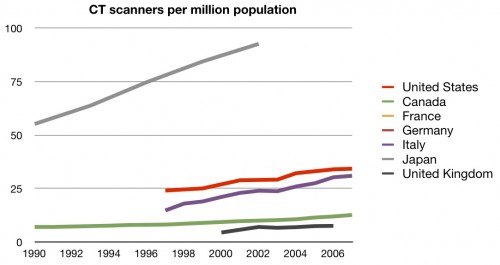 We do. In fact, we have more, per million people, than almost any other country in the world. Japan, however, makes us look deficient. They have about three times as many as we do. To be honest, I have no idea why.
We do. In fact, we have more, per million people, than almost any other country in the world. Japan, however, makes us look deficient. They have about three times as many as we do. To be honest, I have no idea why.
How about MRI machines? These scanners are even more advanced (and more expensive) than CT scanners. Do we have many of them?
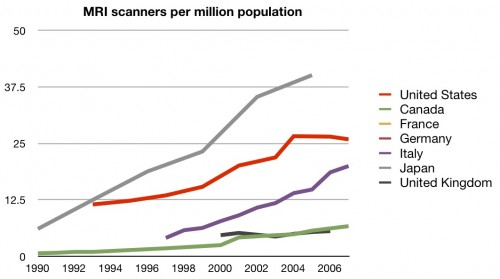 Once again, we do. More than almost all other countries, yet fewer than Japan. They sure do like their scanners in Japan.
Once again, we do. More than almost all other countries, yet fewer than Japan. They sure do like their scanners in Japan.
But diagnosis isn’t the only technology that is important to people. Access to high-tech procedures is considered a metric of quality as well. So let’s look at many of those, specifically transplants.
We’ll go in in alphabetical order, starting with bone marrow transplants:
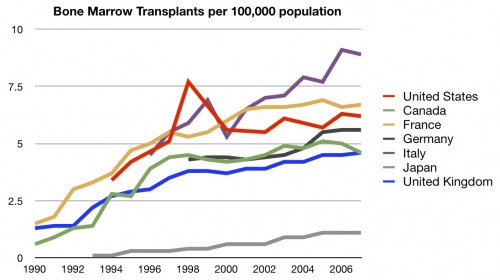 Well, we’re not the worst, but not the best either. Middle of the road here. I should note that Japan is down at the bottom. Maybe that’s because they spent too much on scanners, or maybe they choose to treat patients in other ways.
Well, we’re not the worst, but not the best either. Middle of the road here. I should note that Japan is down at the bottom. Maybe that’s because they spent too much on scanners, or maybe they choose to treat patients in other ways.
How about heart transplants?
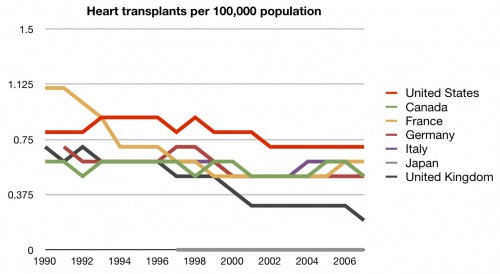 We are number one here. We do more heart transplants per 100,000 people than any comparable country. The differences aren’t huge at a population level, but to those that receive new hearts, the difference may be life saving.
We are number one here. We do more heart transplants per 100,000 people than any comparable country. The differences aren’t huge at a population level, but to those that receive new hearts, the difference may be life saving.
Kidney transplants:
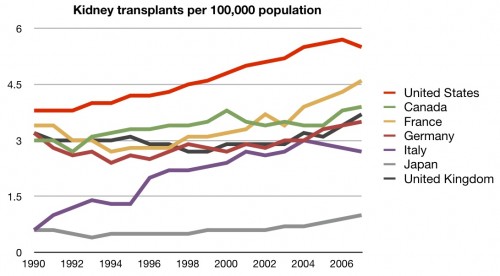 We are solidly number one here. More kidney transplants are performed in the United States per 100,000 people than in any comparable country. For people on dialysis, this can be a life saving, or massively life improving procedure.
We are solidly number one here. More kidney transplants are performed in the United States per 100,000 people than in any comparable country. For people on dialysis, this can be a life saving, or massively life improving procedure.
Finally, how about liver transplants?
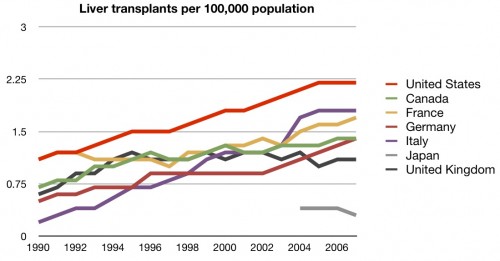 As with other solid organ transplants, you are more likely to get one in the United States than comparable countries. Score for the US.
As with other solid organ transplants, you are more likely to get one in the United States than comparable countries. Score for the US.
I feel compelled to present one more metric. One of the common memes presented about the US compared to other countries is that people who need dialysis may see it withheld because of rationing. So you’d expect to see much higher rates of dialysis in the US than in other countries:
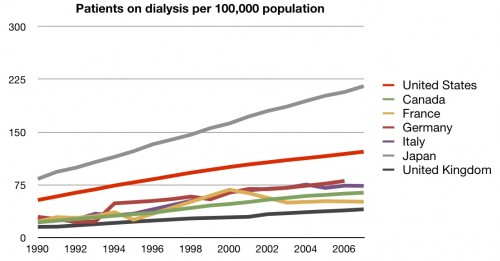 There are far more patients on dialysis per 100,000 in Japan than in any of the other countries; this may be because of their low rates of kidney transplants. But the US uses dialysis more commonly than the rest of the G8 countries. This doesn’t mean rationing is necessarily occurring, but it does mean that dialysis is less common in those other countries.
There are far more patients on dialysis per 100,000 in Japan than in any of the other countries; this may be because of their low rates of kidney transplants. But the US uses dialysis more commonly than the rest of the G8 countries. This doesn’t mean rationing is necessarily occurring, but it does mean that dialysis is less common in those other countries.
So, overall, the United States is a great place to be with respect to both scanning technology and for high tech interventions, like transplants. If that’s where you measurement of quality ends, then we do look really great.
More importantly, however, does this technology translate into better outcomes? More on that tomorrow.
Here’s the second scorecard:
And here’s the running total for the series:

A further explanation of these charts can be found here.

